Part 6 – The Reformation’s Dynamic Duo
Above: Lucas Cranach the Elder, The Holy Kinship (1509)/Portrait of Martin Luther (1528) both by Lucas Cranach the Elder
Creative marketing – it’s what you do when you’ve got to do something drastic to get people back in your corner, keep the money coming in, keep yourself from drowning in debt, recreate your image or reputation, get a boost of new energy and enthusiasm and give folks out there a new vision for life and the world.
I’ll never forget the time our family was on a trip a number of years ago and we were in need of some fuel. As we turned onto a street lined with gas stations, I began pointing out our options: Shell, SuperAmerica, bp… “bp!” yells our oldest child in the backseat, “those are the nice people who are cleaning up the ocean!”…Ah, yes, there we have it, a perfect example of the genius of creative marketing. I began explaining to her that bp is making a lot of commercials about cleaning up the ocean because they were responsible for making it a major mess in the first place! This made no sense to her.
Creative marketing, social media campaigns, viral images and videos, even performance art – we tend to think of these all as modern ideas, but they are not. In fact, we have Martin Luther and his Roman opponents to credit for the birth of many of these. For example, with the invention of the printing press, Luther’s 95 arguments about the state of the Christian Church in his day, and in particular the selling of indulgences, wasn’t just a notice hung on the door of a cathedral inviting other scholars to a hearty debate. His theses were reprinted and circulated (against Luther’s permission or knowledge) and then translated into German and reprinted and circulated again which placed his thoughts about the Church into the hands of nearly every German and European who could read. It all started a movement Luther was at first unprepared to deal with. And it was the first ever anything had “gone viral”. It wasn’t long before Luther was embracing the new “technology” and using it to his advantage – that printing press became a very handy thing. And when he met and decided to team up with an artist named Lucas Cranach (the Elder) – the two became a dynamic duo to be reckoned with. Luther wrote and Cranach drew, painted and printed. The world changed.
Martin Smells a Rat
He was born into the infamous Italian Medici family. At eight years of age he was appointed a bishop of the Church (that’s right, an 8-year old bishop if you can believe it), at age thirteen he became a cardinal (red hat, robe, shoes and all), and finally at age 37 Giovanni di Lorenzo de’ Medici became Pope Leo X of the Holy Catholic Church. In that day and age, becoming the head of the Body of Christ had nothing to do with spiritual virtues – how kind, how humble or how spiritually wise you were. The high offices of the church were just another route to power and fame. (Luther was disheartened when he and a fellow monk went to the Vatican City in 1510 to make an appeal over an issue concerning their monastery. He would later admit that terrible thoughts had entered his mind as he performed all the acts offered in Rome, such as climbing the very stairs Jesus traversed at the palace of Pilate, in order to reduce his and his family’s time in purgatory: “What if it’s not true?”)
The instant Leo seized the papal crown in 1513, his excessive and extravagant tastes were to be met:
- An expensive upgrading of the papal palace
- Elaborate banquets and masquerade balls (allowing bishops and cardinals to dance the night away with lovely ladies)
- Plenty of his favorite food: peacock tongues
- Time for leisure activities on the private papal island hunting rabbits and wild boar, or when tired with that, a leopard or some other exotic game that had been brought special from Africa
- Fawning over his favorite gift and pet – an elephant from the King of Portugal (When the beast fell ill the papal physicians gave it a laxative comprised of pure gold no less which unfortunately was of no help. Leo had Raphael paint a large fresco in memory.)
And just how did Leo and the popes who proceeded him fund all this revelry? With some creative marketing, duh. Across the empire, priests were selling indulgences, or certificates of assurance for salvation for oneself or for a loved one. These certificates were worth years off your time spent in purgatory. The more your bought the sooner you could enter through the pearly gates after death. Johannes Tetzel, the cunning priest soliciting the common folk in Luther’s vicinity, had a cutesy saying:
As soon as the coin in the coffer rings, The soul from purgatory springs! – Johannes Tetzel
The more desperate Rome became for funds, the more creative Tetzel and others like him got. Eric Metaxas writes: “If you needed to raise what was then the equivalent of billions of dollars from the back of a wagon, Tetzel was your man. It is true that he would often say things that were technically not true – which is to say, doctrinally false – but if he could gin up the generosity of the faithful in doing so, the powers that be would look the other way. After all, what was good for business was good fro business.” (p. 100)*
*Martin Luther: The Man Who Rediscovered God and Changed the World (2017) by Eric Metaxas
The closer he got to what he knew had to be hidden somewhere in Scripture, the truth of what is required to live a life of faith and gain eternal salvation, the more frustrated and furious Luther became with the ways in which the Church was operating. That Tetzel fellow was the slimy, wormy “straw that broke the camels back,” and caused Luther’s writing of the 95 theses.
Over the next few years, through correspondence with representation from both Rome and the Empire, Luther more and more began to believe “that he was dealing directly with the powers of hell.” * So stanch were these men to defend the papacy and even declare it without err, Martin believed the papacy to be none other than the Antichrist spoken of in the New Testament.
* Metaxas, p.182
Martin Does a Thing
Scene: City of Wittenberg, Germany
Time: 9am on December 10, 1520 on the 60-day anniversary of Martin Luther receiving a papal bull (or decree) warning him of excommunication from the Church
Setting: The butchering yard, outside the Wittenberg city gate. A large pyre has been erected around which a crowd of several hundred faculty and students from the city University are gathered. The poster invite back on the campus had read: “a pious and religious spectacle, for perhaps now is the time when Antichrist must be revealed.” The event has been organized by one of Luther’s avid students, Johannes Agricola and was staged at the very spot where clothing of those who had died of the plague were burned.
(Martin Luther steps forward)
“Luther cast into the flames one after another the writings of the false church. Papal decrees were now defiantly hurled into the fire, and even a book of canon law found its way into the flames…And then, as these other works burned, Luther with a sense of drama like some magician reached into his cloak and produced the very papal bull (edict) that threatened to excommunicate him. He spoke the words from Psalm 21:10 – on which he was during this time lecturing –
Because you have confounded the truth of God, today the Lord confounds you. Into the fire with you! – Psalm 21:10
And then in a final flourish, brazen and wild he flung the papal decree into the raging flames.” *
…and that, boys and girls, is how performance art began. Luther was officially excommunicated on January 3, 1521.
*Metaxas, p. 198
Martin Finds a PR Man
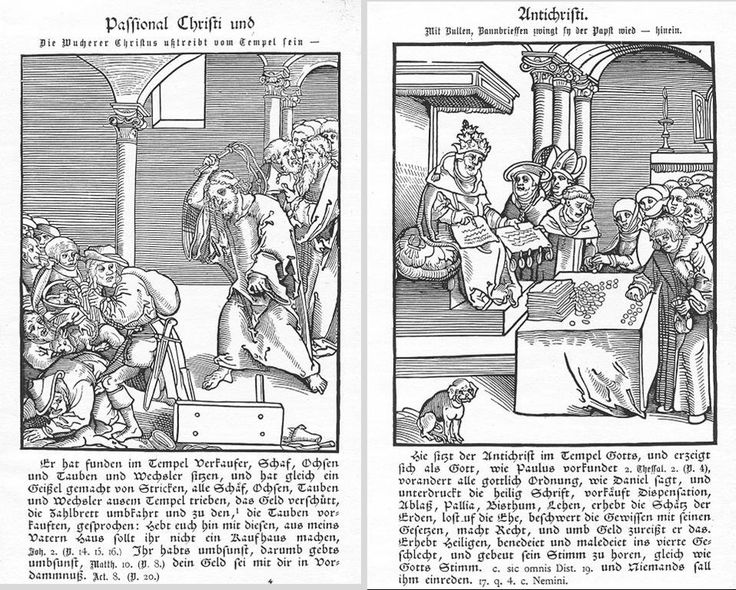
Passional of Christ and Antichrist (1521), woodcut by Lucas Cranach the Elder (Jesus drives out the money changers/The Pope sells indulgences)
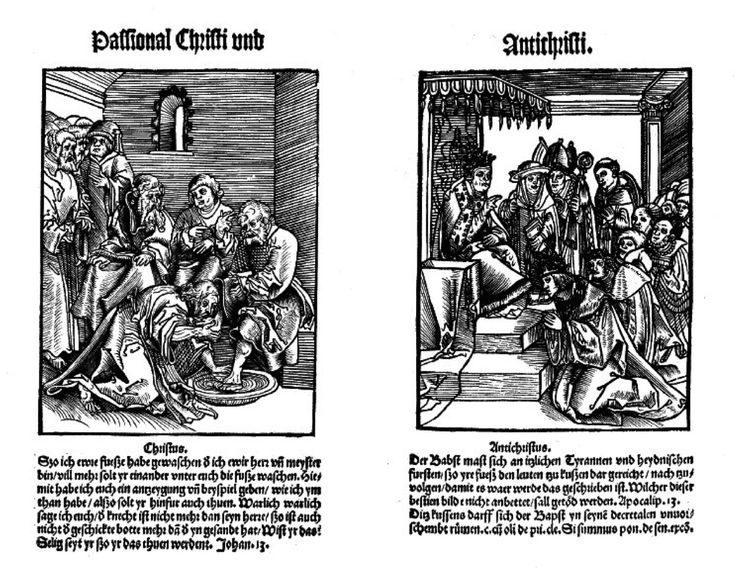
Passional of Christ and Antichrist (1521), woodcut by Lucas Cranach the Elder (Jesus washes/kisses the feet of the disciples/The Popes feet are kissed)
Sometime around 1520, Luther was introduced to the Saxony court painter, Lucas Cranach the Elder. Cranach soon produced a portrait of Luther that was to appear on Luther’s pamphlets and broadsheets that he was pumping out against Rome regularly. The two seemed to hit it off right away and would remain life-long friends.
When they met, Luther was the head of the theology faculty in Wittenberg and was vicar-general of eleven monasteries. As the official court painter to Frederick, Duke of Saxony, Cranach was in charge of:
- Designing, decorating, furnishing and refurbishing the five castle residences of the princes
- Planning royal festivals and celebrations in the castles
- Decorating the altar pieces for the churches
- Preparing City Square for jousting tournaments
- Outfitting and accompanying the princes on their season hunts in the royal game preserves with brushes ready to record the “kills”
- Designing or procuring wall hangings and frescoes, regalia for horses and carriages, new fall and summer uniforms for court servants
- Any other creative tasks (like the time Cranach created a gingerbread mold for the Duke’s grandsons)
While both gentlemen were busy with all their given responsibilities, when Luther asked Cranach to help him continue to speak out against the corruption of the Church through the papacy, Cranach was up to the challenge.
Their first collaboration was a 26-page booklet, Passional of Christ and Antichrist. In it were 13 pairs of woodcut illustrations contrasting scenes from the life of Jesus with those of the pope. Under each image of Christ was a New Testament text chosen by Luther’s university colleague, Philip Melanchthon. Under each image of the pope was a quote from a papal decree or canonical law selected by Johann Schwertfeger, also a university colleague of Luther’s.
The project was impressive and a first in its image-centric format which rose out of Luther’s conviction that people learn and are better able to understand through images. And with that endeavor, this dynamic duo launched a serious anti-Rome media campaign. From then on Luther depended on Cranach to visually complement what he preached and wrote – to make himself and his message attractive to the people. And Cranach depended on Luther to defend art’s place in the church.
Martin and Lucas Create a Masterpiece
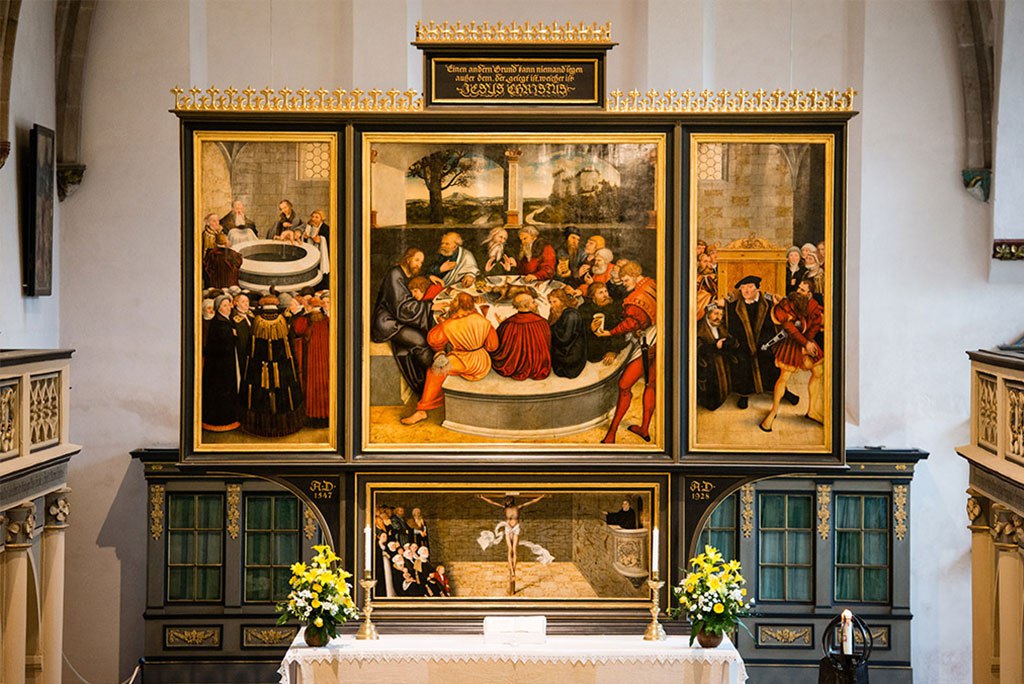
The Wittenberg Altarpiece (1547) by Lucas Cranach the Elder (LCMS/Erik M. Lunsford)
The crowning piece of art said to be a perfect blending of Luther’s theology and Cranach’s skills is the Wittenberg Altarpiece, also know as the Reformation Altarpiece. It is still to be viewed in St. Mary’s Church in Wittenberg, Germany. (Those in the U.S. may visit a reproduction of the piece in St. Louis, Missouri at the Lutheran Church – Missouri Synod’s International Center where it was installed in September of 2016.) A long time in the making, Cranach finally finished the altarpiece the year Luther died, 1547.
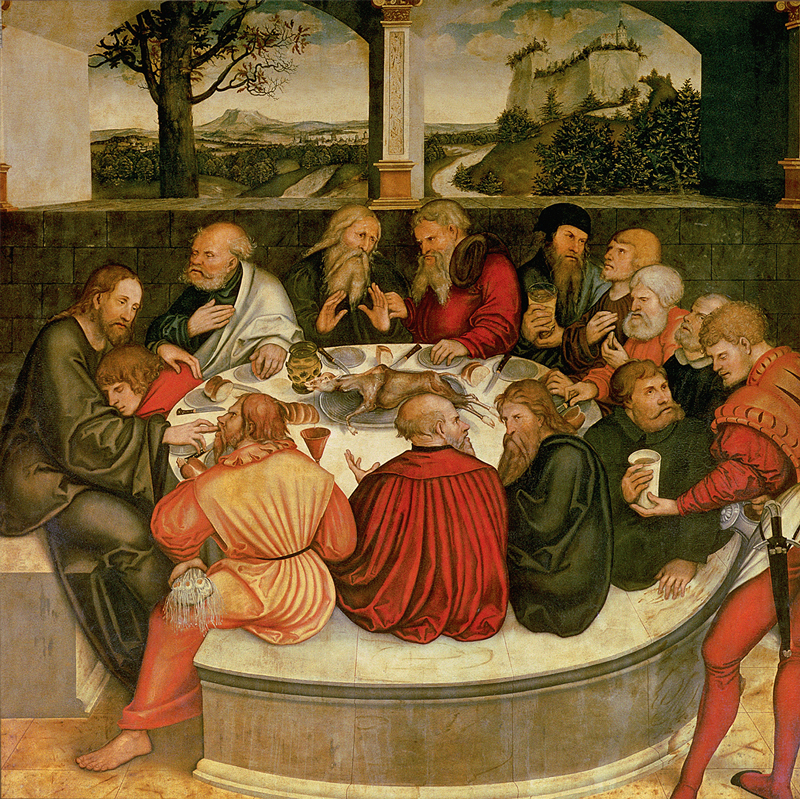
The Wittenberg Altarpiece, center panel (1547) by Lucas Cranach the Elder
At the center of the panel is the scene of the Last Supper with Christ, the disciples and one unexpected guest…Junker Jorge, Luther in his Wartburg disguise (read Part 3 to learn more). A young Lucas Sr or perhaps Lucas the Younger is serving filling his cup. This unique addition is not a pretentious act, but an assurance given to all who looked to Luther for their freedom and release from the oppression of the Church that the battle had been won.
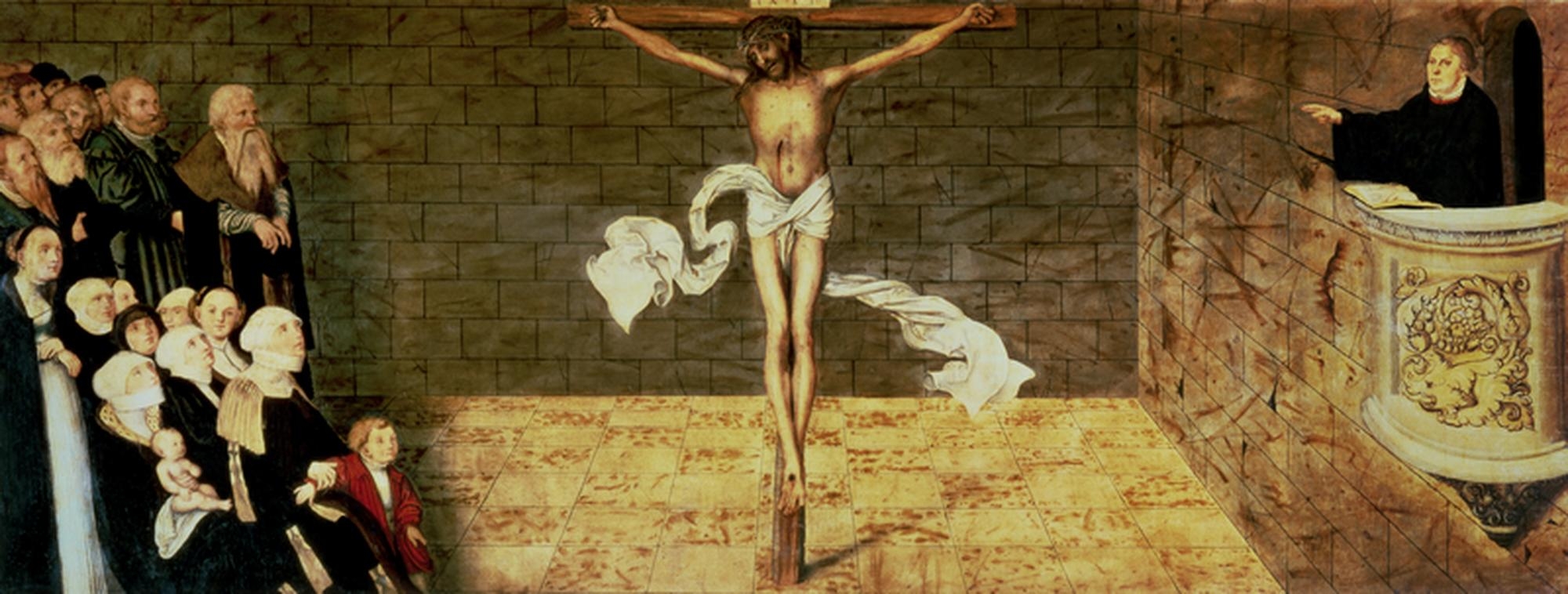
The Wittenberg Altarpiece, lower panel (1547) by Lucas Cranach the Elder
The panel below features Christ crucified, a visual of “the gospel”, being preached by Luther on the right to the congregation on the left made up of Luther’s family and an elderly Cranach (standing next to the wall with the men). The young girl peering out at the viewer may be Luther’s daughter, Magdalena, who died at age thirteen and left Luther and his wife quite devastated with grief.
The side panels feature baptism and confession, both important acts in the life of a believer along with communion and the hearing the word according to Luther’s teachings. Included in these panels are more of Luther and Cranach’s colleagues and friends. These apostles of the 16th-century were the “heroes” who served to reconnect the common people with Christ and the biblical apostles of the early church – a connection the Roman Church over the centuries had greedily diminished, exploited and monetized.
Cranach Trivia
If you’ve never heard of Lucas Cranach the Elder until just now, that’s a shame. He really is one the greatest artists of the Renaissance. According to Cranach expert, Steven Ozment: “No other European artist, neither Durer in the 16th century nor Picasso in the 20th, who lived to be eighty and had all the technical advantages of the modern world, created as much original art in as many genres and with such novelty as did Cranach and his workshop over the artist’s lifetime.” *
A few Cranach the Elder facts:*
- Roughly 1,000 Cranach paintings exist today
- Ran a workshop which included sons, Hans and Lucas the Younger, along with fifteen apprentices and assistants
- Was nicknamed “Fast Brush” for his quick work
- Served a total of 30 years on the Wittenberg city council
- Became one of Wittenberg’s wealthiest residents
- Was a real estate developer and property owner
- Ran a publishing house and full-service pharmacy
- Maintained a fairly neutral religious position and had friends and hefty commissions on both sides of the Reformation debate
- Is said to have accepted Christ only on his deathbed while confessing to his son, Lucas Jr.
*The Serpent and the Lamb – Cranach, Luther and the Making of the Reformation (2011) by Steven Ozment
Final Thoughts
I had never heard of all this “Luther-Cranach Mash-up” business until visiting the exhibit in Minneapolis on Martin Luther at the Minneapolis Art Institute in early 2017. I was expecting to see some cool artifacts and portraits and what-have-you. I was not expecting to find such a wonderful history where an artist served with his gifts to the benefit of the gospel in such a way as Cranach did.
Cranach really was so critical to the entire spreading of Luther’s cause. It is equally amazing to know that God was using Cranach all the while slowly drawing him to Himself. Not until his final hour did Cranach turn and gaze into the full face of Christ as he entered into glory – a sinner saved by grace alone.
Martin Luther…Father of the Protestant Reformation.
Lucas Cranach the Elder…Painter of the Protestant Reformation.
Together…Dynamic Duo.
Additional source: Martin Luther – Treasures of the Reformation, Catalogue from the Here I Stand Luther Exhibitions USA 2016.
Down an Ancient Path
The BIRCH TREE STUDIO BLOG
